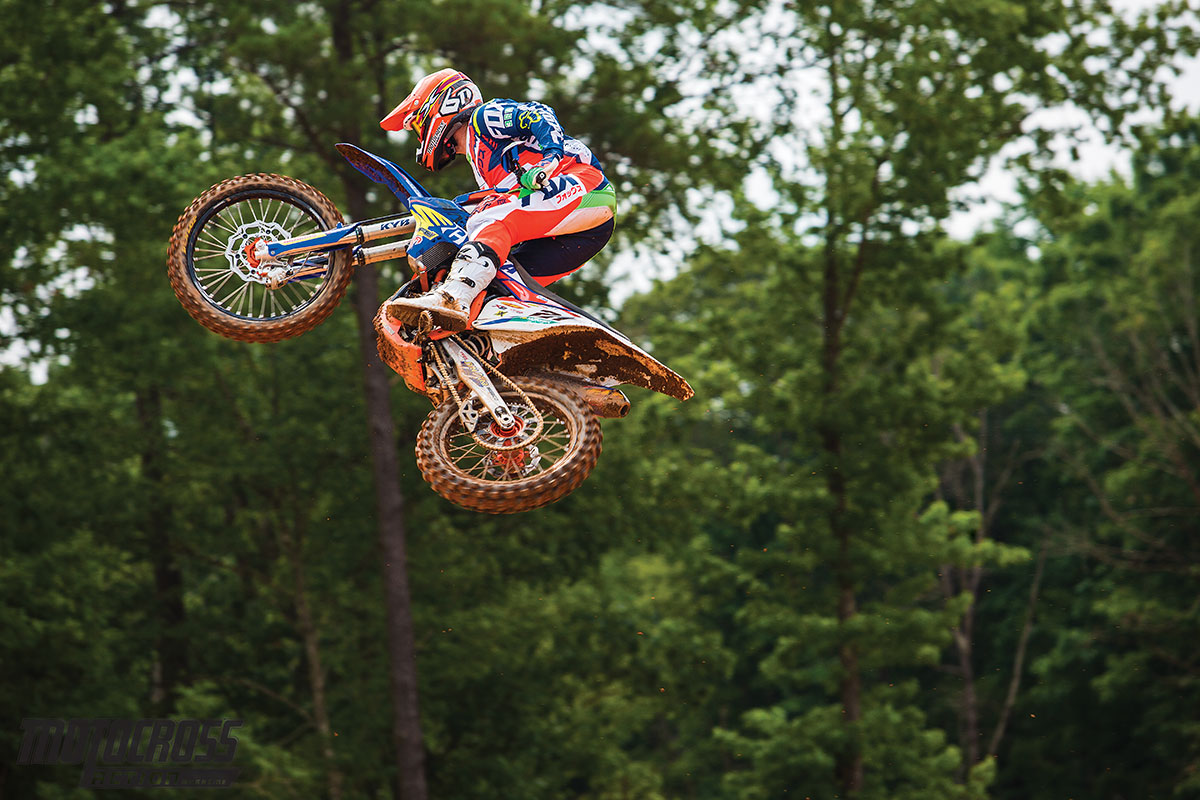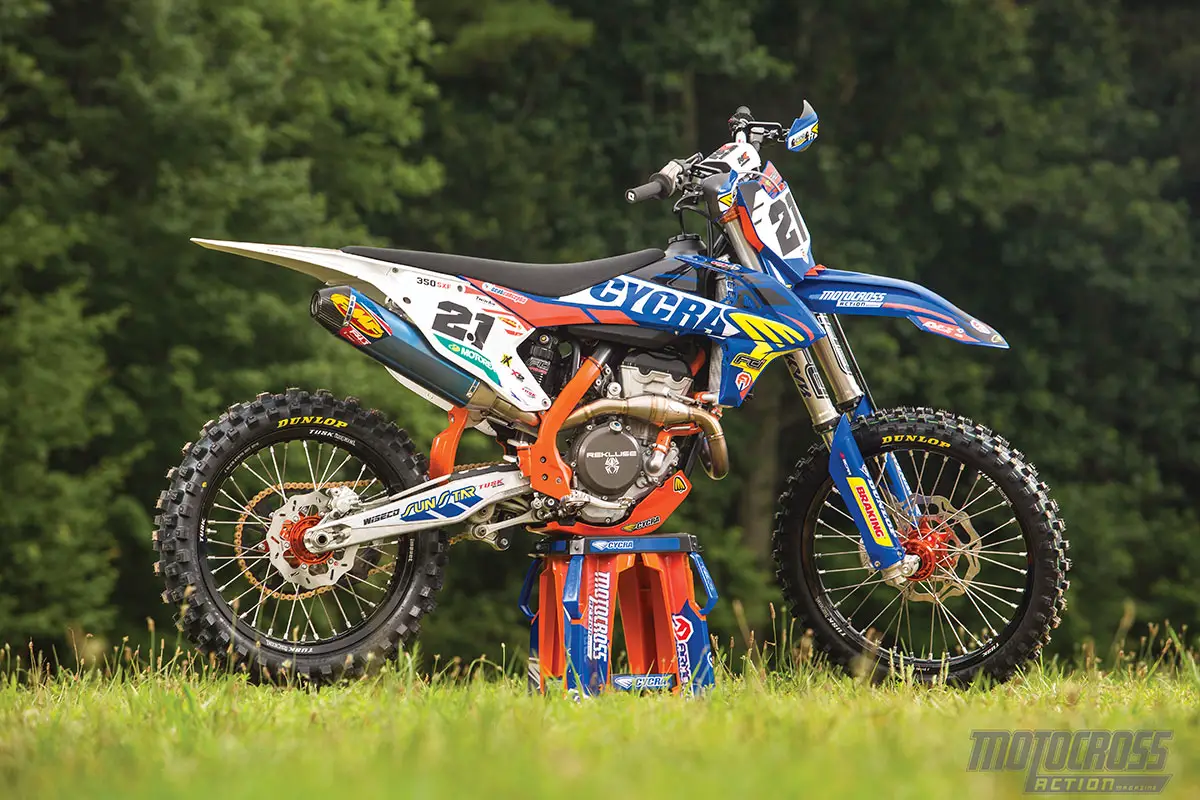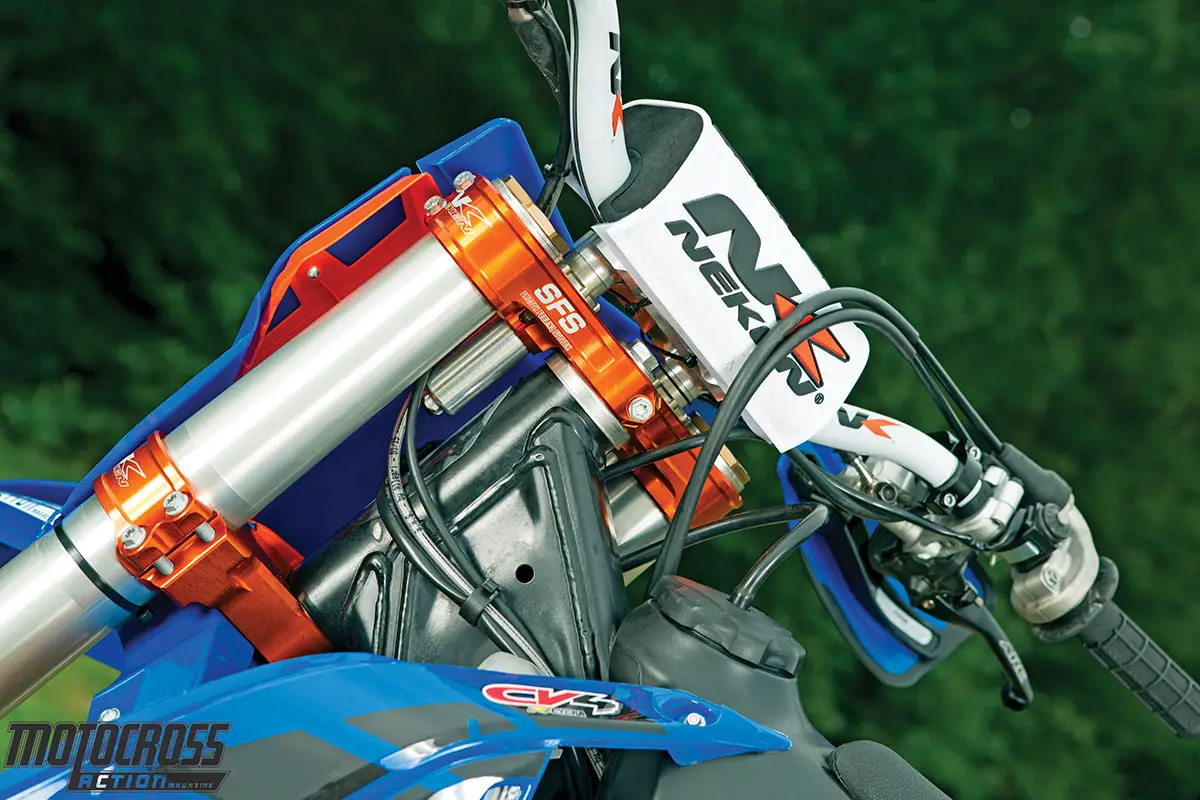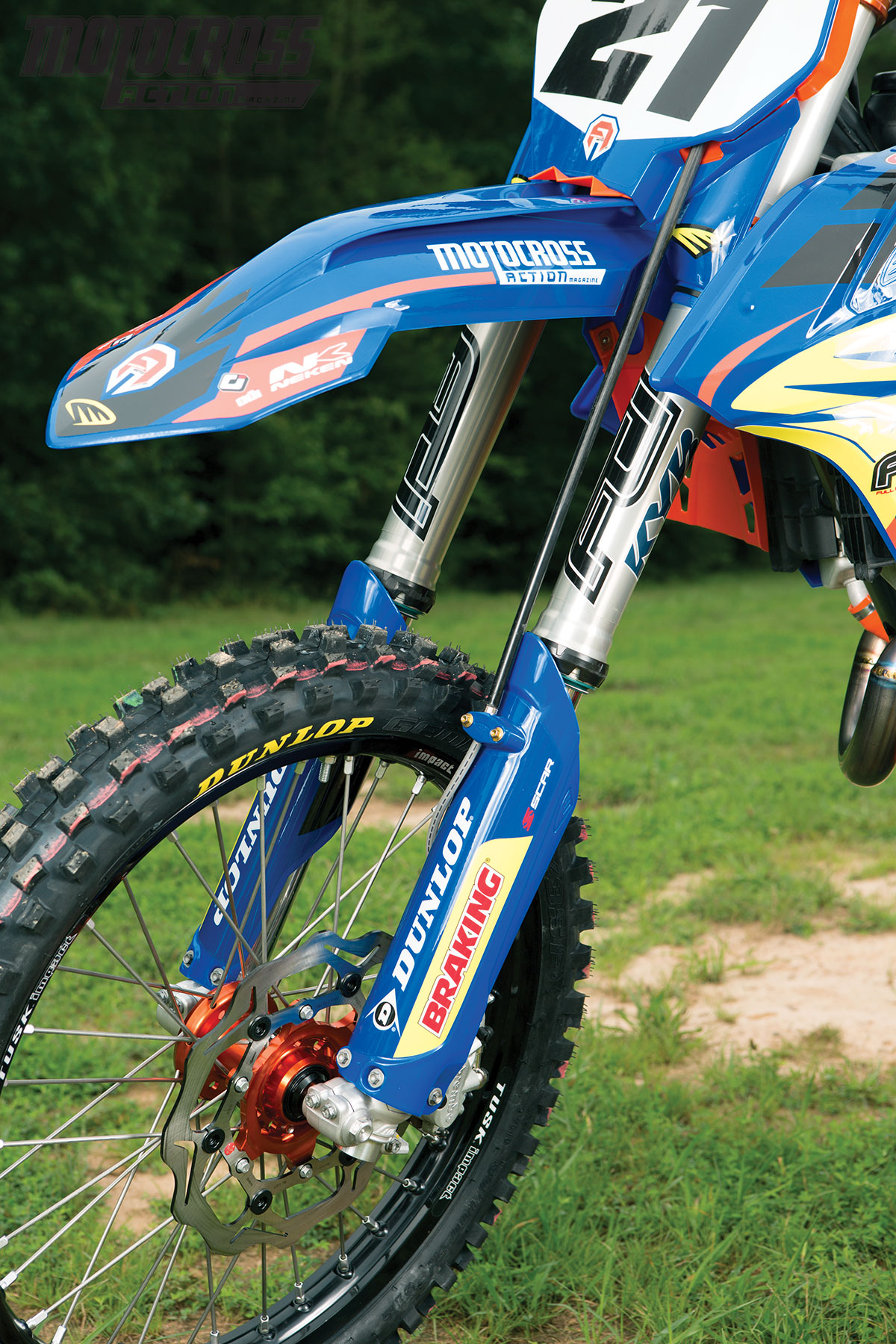MXA RIDES FTI SUSPENSION’S REFURBED 2016 KTM 350SXF
Click on images to enlarge

Every year since its unveiling in 2011, the KTM 350SXF has improved at a snail’s pace. Even so, the 350SXF has been one of the best-selling motocross bikes in KTM’s extensive model line. As a result of the theory that 450 four-strokes are too fast, the KTM 350SXF initially received mixed reviews. It didn’t help that the 350SXF was essentially a man without a country—not legal for 250-class competition and too slow for the 450 class. In Professional racing, the 350 project has largely been a failure. It’s most staunch supporter, Tony Cairoli, dropped his trusted 350SXF during the early going of last year’s Grand Prix campaign in favor of the more-powerful 450SXF.
Let’s not be too hard on the KTM 350SXF, though. It is a great bike for professional practice riders, Vet class racers and those who live in the spaces in between. In general, KTM 350SXF proponents are an impassioned group who desire the agility of a 250 coupled with the power of a detuned 450. You have to give to get on the 350SXF, and like those who wear black nail polish or dye their hair blue, some people were born to stand out.
The 350SXF made a major leap forward in 2016 when KTM recommitted to the idea that a 350cc four-stroke could be an effective race bike. Much of the 2015-1/2 KTM 450SXF Factory Edition technology was used on the 2016 KTM 350SXF. Everything—from the frame to the WP 4CS forks, radiators, air filter and more—was engineered with performance in mind. The biggest changes were made to the engine, which received new cases, a higher crank, a shorter cam chain, a lower cylinder and a slew of other updates. KTM’s aggressive approach netted the 350SXF an additional 1 to 2 horsepower across the entire range. An added dose of power was noticeable on the track, but MXA test riders were mostly intrigued by the decreased weight (down 6 pounds from 2015). But, the real question always centered on the WP forks — an area on the KTM 350SXF that had long been despised. The coil springWP’s 4CS forks were a step in the right direction, but only for a select group of Vet and Novice racers. Everybody else was out of luck/
For 2017 the suspension woes were fixed when KTM spec’ed the new WP AER air forks, but that didn’t help riders who had invested in 2015-2016 KTM 350SXFs. It’s importnat to note that 2015 and 2016 KTM’s are stillgreat bikes—and what makes the biggest difference between them and the 2017 model all comes down to fork performance. If a rider could get the forks on his ’15-16 KTM work as well as the AER forks on the e017 model, his old warhorse would be like new again. But how?

Enter FTI Suspension’s Cal Northrop from Thomasville, North Carolina. MXA has tested many bikes that Cal has worked on, and we have been happy with the performance he gets out of our project bikes. Cal is one of the WP tuners who offers a conversion kit for the WP 4CS forks found on 2015–2016 KTMs of all sizes. Cal takes Yamaha SSS fork internals and does the machine work to put them inside 48mm WP 4CS forks. He offers several different ways to make the mod more affordable than using two sets of forks to make one set.
The donor parts to make MXA’s test bike WP conversion come from 2006 to 2009 YZ250F and YZ450F forks (or 2006 and newer YZ125 and YZ250 two-stroke forks). Cal Northrop scours the internet and buys up any Kayaba SSS forks that he can find — usually spending between $250 and $500 for the old forks. Then, he refurbishes the SSS internals, machines the Kayaba and WP parts to fit together and builds Kayaba SSS forks that fit into KTM 4CS fork legs.
FTI’s Kayaba SSS internals in the WP 4CS forks were, without exaggeration, amazing. All of the problems we encountered with the 4CS units were gone. Instead, the forks were plush beyond compare. With FTI’s valving specs, the front end was progressive and forgiving. It’s fair to say that any KTM owner who is unhappy with the performance of his 4CS forks should seriously consider the FIT Kayaba SSS conversion kit. Northrop’s baseline setting was spot-on for Novice and Intermediate riders. In an endless search for something even better, we asked Cal to install stiffer fork springs. He obliged, keeping the same valving and clicker settings. Although more aggressive, the Kayaba SSS internals still maintained their plushness. Test riders were able to slap down the front end on jumps and push through braking bumps with ease. Best of all, the forks soaked up small chop without blowing into the midstroke and becoming harsh. Simply put, the Kayaba internals were confidence inspiring — something that cannot be said for the WP 4CS forks.
The digits? Cal suggests that interested customers find the Kayaba internals and send them, along with their 4CS forks, to his shop. If the customer provides his own internals, it will cost $400 for the conversion kit and around $200 for labor. Otherwise, FTI Suspension will charge $1200 if you just want to send in your WP 4CS forks and have Northrop do the legwork.

FOR MAXIMUM OUTPUT, THE KTM 350SXF MUST BE RIDDEN AT FULL TILT. SHORT-SHIFTING IS THE WORST THING YOU CAN DO, BECAUSE THE ENGINE DOESN’T START MAKING SERIOUS POWER UNTIL THE NETHER REACHES OF THE RPM RANGE.
For maximum output, the KTM 350SXF must be ridden at full tilt. Short-shifting is the worst thing you can do, because the engine doesn’t start making serious power until the nether reaches of the rpm range. Most riders are inept at understanding the scope of what 13,400 rpm feels like. That’s because conventional wisdom says to shift up before the bike noses over. Guess what? The KTM 350SXF lives in the penthouse of the powerband. The engine benefits from having a progressive nature. Twist the throttle and watch the power climb seamlessly. However, it’s not for everyone. Some MXA test riders like a powerband to have personality. That is to say, they want punch, hit and pizzazz. Fortunately, the 350SXF can be livened up. All it takes is money.

Cal Northrop installed a Vortex preprogrammed ignition. With 10 map settings, we were able to go from mild to wild. There were a myriad of fuel and timing settings, and while these adjustments would have made a substantial difference in a fully modified 350SXF engine, they were still noticeable on our bike. The aggressive setting (Map 4) added a dose of hit at throttle opening. Vortex’s recommended setting—Map 2—generally improved power across the range. There were also maps for retarding the timing, but we would only exercise those options on marbly and hard-packed tracks.
Complementing the Vortex ignition was an FMF MegaBomb header with Factory 4.1 RCT titanium muffler. We’ve had experience with FMF’s KTM 350SXF pipe in the past, and we’re proponents of the broad power it produces. FMF works closely with KTM, so it’s only natural that the Flying Machine Factory would have a winner. Other power-specific modifications were the Wiseco high-compression piston and X2 by Xceldyne titanium valves. Given our druthers, we would have added a tooth to the rear sprocket for a bigger sweet spot in the powerband. Otherwise, there wasn’t much more that needed to be done to the our test 350SXF.
Neken’s SFS air triple clamps have been on the market for several years. While there were initially teething problems with the clamp (the bar mounts would lose air pressure), Neken addressed the issues enough that factory riders use them today. The SFS clamp offers more forgiveness than rubber-mounted clamps. It’s a huge advantage on rough tracks with consecutive chop and for riders with wrist maladies. MXA is a firm believer in the Neken SFS air triple clamp. We hover between 65–75 psi depending on conditions.

We can’t forget to mention a handful of aftermarket parts that sweetened the ride. Things like the Braking rotors, Rekluse manual clutch, Dunlop MX3S tires, ODI lock-on grips, Hammerhead shifter and brake pedal, Twin Air filter, Works Connection hard parts, indestructible Tusk Impact wheels, and Neken bars were great. Cycra Racing, as it is wont to do, used its all-new KTM plastics to doll up the 350SXF. We were enchanted by the blue front fender, fork guards, shrouds, front number plate and Rebound hand guards. Who would have thought that a KTM could look good in blue? Armored Graphix, out of Monroe, North Carolina, made a custom set of graphics for the test.

If you’ve read this far, it either means that you’re a KTM 350SXF fan, are on the fence about buying into the 350 craze or are trying to figure out what all the hubbub is about. Let us put your mind at ease. The KTM 350SXF is here to stay for the foreseeable future and deservedly so. There’s a place on a motocross track for the KTM 350SXF, and because the Austrians have recommitted to the idea, it continues to improve every year. FTI’s KTM 350SXF is a testament to the fact that a mid-sized displacement can compete with the very best. While several MXA test riders still aren’t sold on the KTM 350SXF, all could agree that FTI Racing’s Kayaba SSS conversion for the WP 4CS fork is worth every penny. Yes, it’s that good.
CYCRA RACING KTM 350SXF SUPPLIER CONTACTS
Cycra Racing: www.cycraracing.com
FTI Suspension: www.ftisuspension.com
Tusk Racing: www.tuskoffroad.com
Braking: www.braking.com
Rekluse: www.rekluse.com
Armored Graphix: www.armoredgraphix.com
Seat Concepts: www.seatconcepts.com
Dunlop: www.dunlopmotorcycle.com
ODI: www.odigrips.com
Neken: www.nk-neken.com
ARC Levers: www.arclevers.com
FMF Racing: www.fmfracing.com
Scar Racing: www.scar-racing.com
Sunstar: www.sunstar-mc.com
CV4 Products: www.cvproducts.com
Hammerhead: www.hdmoto.com
Twin Air: www.twinairusa.com
Motorex: www.motorexusa.com
Vortex: www.vortexcdi.com
Wiseco: www.wiseco.com
Works Connection: www.worksconnection.com
Xceldyne: www.xceldyne.com






Comments are closed.